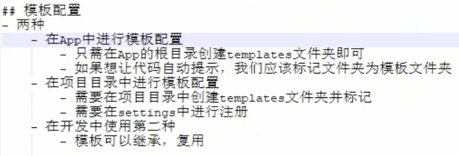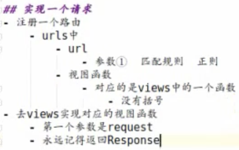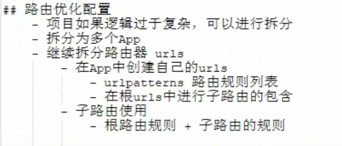
1、模板使用方式1:在App目录下建立templates文件夹
views.py
from django.http import HttpResponse
from django.shortcuts import render
# Create your views here.
def hello(request):
return HttpResponse("views中的hello函数返回Hello")
def index(request):
return render(request, "index.html")
urls.py
from django.contrib import admin
from django.urls import path
from App import views
urlpatterns = [
path('admin/', admin.site.urls),
path('hello/', views.hello),
path('index/', views.index),
]

settings.py
# Application definition
# django开头的为Django内置的应用
INSTALLED_APPS = [
'django.contrib.admin',
'django.contrib.auth',
'django.contrib.contenttypes',
'django.contrib.sessions',
'django.contrib.messages',
'django.contrib.staticfiles',
'App'
]
2、模板使用方式2:在项目目录下建立templates文件夹
settings.py
TEMPLATES = [
{
'BACKEND': 'django.template.backends.django.DjangoTemplates',
'DIRS': [
os.path.join(BASE_DIR, 'templates')
],
'APP_DIRS': True,
'OPTIONS': {
'context_processors': [
'django.template.context_processors.debug',
'django.template.context_processors.request',
'django.contrib.auth.context_processors.auth',
'django.contrib.messages.context_processors.messages',
],
},
},
]
views.py
from django.http import HttpResponse
from django.shortcuts import render
# Create your views here.
def hello(request):
return HttpResponse("views中的hello函数返回Hello")
def index(request):
return render(request, "index.html")
def home(request):
return render(request, "home.html")
urls.py
from django.contrib import admin
from django.urls import path
from App import views
urlpatterns = [
path('admin/', admin.site.urls),
path('hello/', views.hello),
path('index/', views.index),
path('home/', views.home),
]
3、Project下建立多App路由使用

1) python manage.py startapp Two
工程下建立Two的App
2)settings.py注册Two
INSTALLED_APPS = [
'django.contrib.admin',
'django.contrib.auth',
'django.contrib.contenttypes',
'django.contrib.sessions',
'django.contrib.messages',
'django.contrib.staticfiles',
'App',
'Two'
]
3) Two 下建立urls.py
from django.conf.urls import url
from Two import views
urlpatterns = [
url('index/', views.index),
]
4) 工程下urls (include)
from django.contrib import admin
from django.urls import path, include
from App import views
urlpatterns = [
path('admin/', admin.site.urls),
path('hello/', views.hello),
path('index/', views.index),
path('home/', views.home),
path('two/', include('Two.urls')),
]
